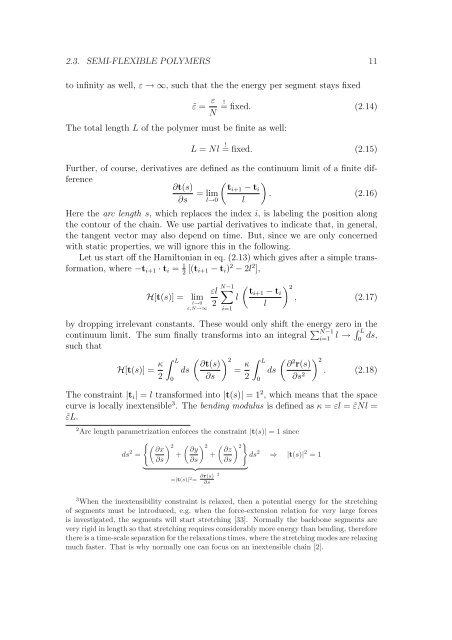Polymers in Confined Geometry.pdf
Polymers in Confined Geometry.pdf
Polymers in Confined Geometry.pdf
Create successful ePaper yourself
Turn your PDF publications into a flip-book with our unique Google optimized e-Paper software.
2.3. SEMI-FLEXIBLE POLYMERS 11<br />
to <strong>in</strong>f<strong>in</strong>ity as well, ε → ∞, such that the the energy per segment stays fixed<br />
˜ε = ε<br />
N<br />
The total length L of the polymer must be f<strong>in</strong>ite as well:<br />
!<br />
= fixed. (2.14)<br />
L = Nl ! = fixed. (2.15)<br />
Further, of course, derivatives are def<strong>in</strong>ed as the cont<strong>in</strong>uum limit of a f<strong>in</strong>ite difference<br />
<br />
∂t(s) ti+1 − ti<br />
= lim<br />
.<br />
∂s l→0 l<br />
(2.16)<br />
Here the arc length s, which replaces the <strong>in</strong>dex i, is label<strong>in</strong>g the position along<br />
the contour of the cha<strong>in</strong>. We use partial derivatives to <strong>in</strong>dicate that, <strong>in</strong> general,<br />
the tangent vector may also depend on time. But, s<strong>in</strong>ce we are only concerned<br />
with static properties, we will ignore this <strong>in</strong> the follow<strong>in</strong>g.<br />
Let us start off the Hamiltonian <strong>in</strong> eq. (2.13) which gives after a simple transformation,<br />
where −ti+1 · ti = 1<br />
2 [(ti+1 − ti) 2 − 2l 2 ],<br />
N−1<br />
εl<br />
H[t(s)] = lim<br />
l→0 2<br />
ε,N→∞ i=1<br />
<br />
2 ti+1 − ti<br />
l<br />
, (2.17)<br />
l<br />
by dropp<strong>in</strong>g irrelevant constants. These would only shift the energy zero <strong>in</strong> the<br />
cont<strong>in</strong>uum limit. The sum f<strong>in</strong>ally transforms <strong>in</strong>to an <strong>in</strong>tegral N−1 i=1 l → L<br />
0 ds,<br />
such that<br />
H[t(s)] = κ<br />
L 2 ∂t(s)<br />
ds =<br />
2 ∂s<br />
κ<br />
L 2 ∂ r(s)<br />
ds<br />
2 ∂s2 2 . (2.18)<br />
0<br />
The constra<strong>in</strong>t |ti| = l transformed <strong>in</strong>to |t(s)| = 1 2 , which means that the space<br />
curve is locally <strong>in</strong>extensible 3 . The bend<strong>in</strong>g modulus is def<strong>in</strong>ed as κ = εl = ˜εNl =<br />
˜εL.<br />
2Arc length parametrization enforces the constra<strong>in</strong>t |t(s)| = 1 s<strong>in</strong>ce<br />
ds 2 ∂x 2 2 <br />
2<br />
∂y ∂z<br />
= + + ds<br />
∂s ∂s ∂s<br />
<br />
2 ⇒ |t(s)| 2 = 1<br />
=|t(s)| 2 ŕ ŕ<br />
ŕ<br />
= ŕ<br />
∂r(s) ŕ2<br />
ŕ<br />
ŕ ∂s ŕ<br />
3 When the <strong>in</strong>extensibility constra<strong>in</strong>t is relaxed, then a potential energy for the stretch<strong>in</strong>g<br />
of segments must be <strong>in</strong>troduced, e.g. when the force-extension relation for very large forces<br />
is <strong>in</strong>vestigated, the segments will start stretch<strong>in</strong>g [33]. Normally the backbone segments are<br />
very rigid <strong>in</strong> length so that stretch<strong>in</strong>g requires considerably more energy than bend<strong>in</strong>g, therefore<br />
there is a time-scale separation for the relaxations times, where the stretch<strong>in</strong>g modes are relax<strong>in</strong>g<br />
much faster. That is why normally one can focus on an <strong>in</strong>extensible cha<strong>in</strong> [2].<br />
0













